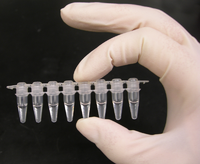
Photo from wikipedia
Background Plague is a highly fatal disease caused by Yersinia pestis . Late diagnosis hampers disease outcome and effectiveness of control measures, induces death and disease spread. Advance on its… Click to show full abstract
Background Plague is a highly fatal disease caused by Yersinia pestis . Late diagnosis hampers disease outcome and effectiveness of control measures, induces death and disease spread. Advance on its diagnosis was the use of lateral flow rapid diagnostic test (RDT). Methods We assessed the performance of the plague RDT based on Y. pestis F1 antigen detection more than 15 years after its deployment in Madagascar. We compared the RDT with bacteriological culture results, using data from plague notified cases collected during the periods for which both tests were performed independently and systematically. Results Used with bubonic plague (BP) patient samples, RDTs had a sensitivity of 100% (95% CI: 99.7–100%), a specificity of 67% (95% CI: 64–70%) with a good agreement between bacteriology and RDT results (86%; κ = 0.70, 95% CI 0.67–0.73). For pneumonic plague (PP), RDT had a sensitivity of 100% (95% CI: 91–100%) and a specificity of 59% (95% CI: 49–68%) and concordance between the bacteriological and plague RDT results was moderate (70%; κ = 0.43, 95% CI 0.32–0.55). Analysis focusing on the 2017–2018 plague season including the unprecedented epidemic of PP showed that RDT used on BP samples still had a sensitivity of 100% (95% CI: 85–100%) and a specificity of 82% (95% CI: 48–98%) with a very good agreement with bacteriology 94% (κ = 0.86, 95% CI 0.67–1); for PP samples, concordance between the bacteriological and plague RDT results was poor (61%; κ = − 0.03, 95% CI -0.17 – 0.10). Conclusions RDT performance appeared to be similar for the diagnosis of BP and PP except during the 2017 PP epidemic where RDT performance was low. This RDT, with its good sensitivity on both plague clinical forms during a normal plague season, remained a potential test for alert. Particularly for BP, it may be of great value in the decision process for the initiation of therapy. However, for PP, RDT may deliver false negative results due to inconsistent sample quality. Plague diagnosis could be improved through the development of next generation of RDTs.
Journal Title: BMC Infectious Diseases
Year Published: 2020
Link to full text (if available)
Share on Social Media: Sign Up to like & get
recommendations!